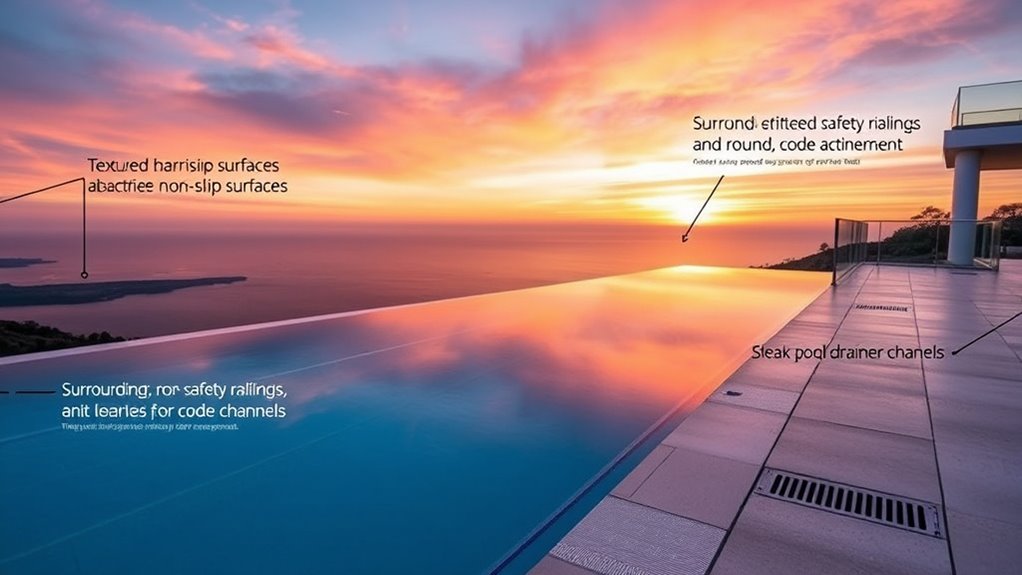When planning your infinity pool, prioritize safety by following local building codes, installing secure fencing, and using safety alarms around the area. Confirm the structure is designed and built by qualified professionals who adhere to regional standards for waterproofing, electrical safety, and load capacity. Regular inspections and maintenance help prevent leaks and damage. Staying compliant with safety regulations not only protects users but also ensures your pool remains long-lasting and safe. Further details can guide you through each step.
Key Takeaways
- Ensure compliance with local building codes, safety regulations, including fencing, depth markers, and electrical standards.
- Work with qualified engineers familiar with infinity pool design to ensure structural safety and proper waterproofing.
- Install safety barriers, alarms, and provide vigilant supervision to prevent accidents, especially around the edges.
- Obtain necessary permits and adhere to regional safety standards, including drainage and water quality requirements.
- Conduct regular inspections of structural components, edges, and safety features to maintain long-term safety and stability.

Infinity pools create stunning visual effects, but their design and construction come with unique safety and code considerations you need to understand. As you plan or maintain an infinity pool, one of your top priorities should be child safety. These pools often feature open edges and large water surfaces that can pose significant risks to children if proper precautions aren’t in place. You need to guarantee that safety barriers, such as fencing or covers, are installed to prevent accidental falls or access by children when unsupervised. Additionally, installing alarms that alert you when someone enters the pool area can provide an extra layer of security. When it comes to child safety, never underestimate the importance of vigilant supervision and clear safety protocols. Educate your family and visitors about pool safety rules, emphasizing the importance of never swimming alone or unsupervised.
Another critical aspect is maintaining the structural integrity of your infinity pool. These pools often involve complex engineering due to their unique design, which includes a vanishing edge or overflow and extensive reinforcement. If the structural integrity isn’t sound, it could lead to leaks, erosion, or even catastrophic failure. You must work with qualified engineers and contractors who understand the specific requirements of infinity pools, including proper waterproofing, load-bearing capacity, and materials suited for long-term durability. Regular inspections are essential to identify any signs of wear or damage early, especially around the edges where water constantly flows over. Proper maintenance of the pool’s foundation and surrounding landscape is crucial to prevent shifting or settling that could compromise the structure. Remember, the beauty of an infinity pool depends heavily on its stability and safety; neglecting these aspects endangers everyone who uses it.
Furthermore, understanding aviation regulations related to construction safety can help ensure your project complies with national standards and reduces legal risks.
You also need to adhere to local building codes and safety regulations, which can vary depending on your location. These codes often specify requirements for fencing, depth markers, lighting, and emergency equipment. Licensing and permitting processes exist to guarantee your pool’s design complies with safety standards, so don’t skip this step. When you’re designing or renovating your infinity pool, consult with professionals familiar with your area’s codes to avoid compliance issues. Ensuring proper drainage, electrical safety, and water quality standards are met is equally important for long-term safety and functionality.
Frequently Asked Questions
Are There Specific Insurance Requirements for Infinity Pools?
Yes, you need specific insurance coverage for your infinity pool. You should inform your insurer about the pool’s design and features, as liability considerations increase with its unique structure. Adequate coverage helps safeguard you from potential accidents or damages. Make sure your policy accounts for the increased risks, including safety features and fencing, to ensure you’re fully protected should any claims arise related to your infinity pool.
How Do Local Building Codes Vary for Infinity Pool Installations?
You should verify your local building codes because they vary widely for infinity pool construction. Some areas require specific permits, safety barriers, and water filtration standards, especially around the pool edge to prevent accidents. You’ll need to confirm your design complies with these regulations, including structural support and plumbing systems. Visiting your city or county building department will give you clear guidelines to follow, helping you avoid costly violations later.
What Safety Features Are Legally Mandated for Infinity Pools?
You need to prioritize safety features like safety signage, barriers, and alarms for your infinity pool. Legally mandated measures include conducting a risks assessment to identify hazards, installing fencing or covers to prevent accidental falls, and ensuring proper lighting. These features protect swimmers, alert visitors to potential dangers, and meet local regulations. By proactively implementing these safety measures, you create a secure environment where everyone can enjoy your stunning infinity pool worry-free.
Are There Age Restrictions for Pool Users in Infinity Pools?
Age restrictions for infinity pool users vary depending on your local regulations and the specific pool’s user guidelines. Generally, children under a certain age, often 12 or 14, need adult supervision or are restricted from entering. Always check the pool’s posted rules and local codes to guarantee safety. Following these age restrictions helps prevent accidents, ensuring a safe experience for all swimmers.
How Often Should Safety Inspections Be Performed for Infinity Pools?
Don’t wait until something breaks to check your infinity pool; regular safety inspections should be done at least quarterly. You’ll want to focus on water chemistry to prevent issues and guarantee the water remains safe and balanced. Also, inspect drainage systems to avoid costly problems down the line. Staying proactive keeps your pool safe and running smoothly, so you don’t have to play catch-up later.
Conclusion
Just as Icarus once soared too close to the sun, your dreams of an infinity pool can be breathtaking—if you prioritize safety and code compliance. By understanding and respecting these considerations, you guarantee your oasis remains a place of relaxation, not regret. With careful planning, your infinity pool becomes a symbol of elegance and security, reminding you that true luxury lies in enjoying your paradise responsibly. Dream big, but stay safe along the way.









